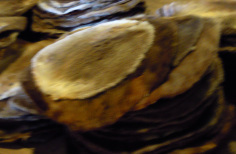Janet Fisher's Blog, page 14
August 21, 2016
HBC Outpost Ready for Celebration
 Nestled on the bank of Oregon’s Umpqua River, this replica of the British Hudson’s Bay Company’s Fort Umpqua will come to life in a couple of weeks for the annual Fort Umpqua Days celebration at Elkton. The event will run all day Saturday and Sunday, September 3 and 4, and I’ll have a booth there to sell my books.
Nestled on the bank of Oregon’s Umpqua River, this replica of the British Hudson’s Bay Company’s Fort Umpqua will come to life in a couple of weeks for the annual Fort Umpqua Days celebration at Elkton. The event will run all day Saturday and Sunday, September 3 and 4, and I’ll have a booth there to sell my books.
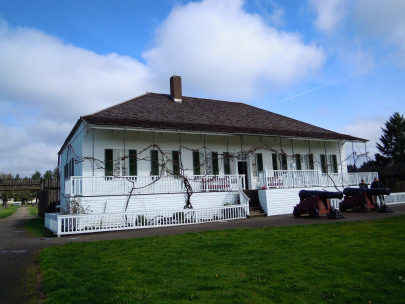 Just last month I stepped into the historic past of the Hudson’s Bay Company’s western headquarters at Fort Vancouver on the Columbia River, touring the commander’s house, shown at left, among other structures there. So I see this Umpqua outpost with new perspective.
Just last month I stepped into the historic past of the Hudson’s Bay Company’s western headquarters at Fort Vancouver on the Columbia River, touring the commander’s house, shown at left, among other structures there. So I see this Umpqua outpost with new perspective.
I’ve attended Fort Umpqua Days celebrations every year since I returned to the family farm near Elkton in 2009, joined the writing team for the event’s pageants, and had a booth the last two years there to sell my first book A Place of Her Own. Still, I feel a difference this year after my event at Fort Vancouver in July where I presented my new book The Shifting Winds, which has many scenes at that HBC headquarters.
Before the Fort Vancouver event I wrote a series of posts for this blog called “The TRUE Shifting Winds,” giving an overview of history leading to the days of my book and the fort’s part in it. Fort Umpqua doesn’t appear in the story, but for me the enhanced sense of Hudson’s Bay Company history wraps Fort Umpqua into the fold.
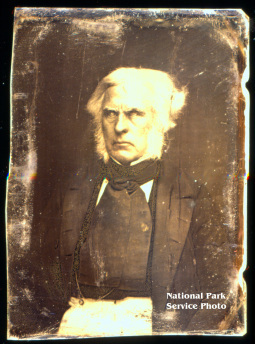 Dr. John McLoughlin, shown at right, commanded the efforts of the British HBC fur trading empire in the Oregon Country and had been at Fort Vancouver only a year or so when he decided to push south through the Umpqua basin with brigades of trappers.
Dr. John McLoughlin, shown at right, commanded the efforts of the British HBC fur trading empire in the Oregon Country and had been at Fort Vancouver only a year or so when he decided to push south through the Umpqua basin with brigades of trappers.
Those expeditions into the southern region became annual events–and rather colorful. Author John A. Hussey quotes Editor Alice Bay Maloney in describing them:
At the head of the brigade rode the leader, a chief trader [or clerk] of the Hudson’s Bay Company, astride a strong limbed Nez Perce horse and armed to the teeth with the best weapons of the day. Directly behind him rode his Indian wife gaily attired in the finest London broadcloth, with a wide-brimmed, feather-trimmed hat atop her wealth of long, shining black hair…. All the men were clad in deerskin….
Hussey adds a description of the brigade by an unnamed priest who wasn’t quite as impressed: “‘The brigade,’ he wrote, ‘is a hideous assemblage of persons of both sexes, devoid of principles and morals,’ and possessed of ‘revolting exteriors.'”
In any case it was during one of these expeditions that members of the brigade selected a site on the Umpqua River they thought would be a good outpost for trade with the local tribes. McLoughlin, concerned about competition from American trappers, wanted to clear the area of beaver and establish a strong foothold.
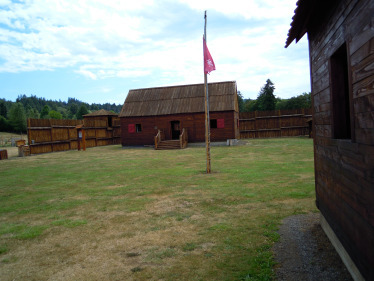 The Hudson’s Bay Company built Fort Umpqua in 1836, and it served the Company well for more than a decade, even after the boundary settlement between Britain and the United States gave the land to the U.S. in 1846.
The Hudson’s Bay Company built Fort Umpqua in 1836, and it served the Company well for more than a decade, even after the boundary settlement between Britain and the United States gave the land to the U.S. in 1846.
The photo at left shows the interior of the reconstructed Fort Umpqua with the HBC flag flying again.
In the next two weeks I’ll write a few more posts about the Hudson’s Bay Company trade in the Oregon Country and about the reconstruction of their southern outpost as the Fort Umpqua Days celebration nears.
Hussey, John A. Champoeg: Place of Transition. Portland, OR: Oregon Historical Society, 1967.
Maloney, Alice Bay (ed.). Fur Brigade to the Bonaventura, John Works California Expedition, 1832-1833 … San Francisco, CA, 1945.


August 14, 2016
At the Fair
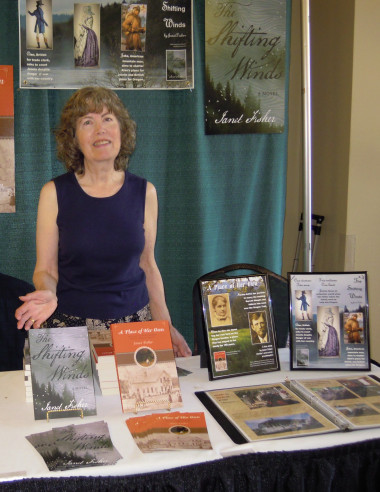 A surge of heat gripped Roseburg during the Douglas County Fair last week, making us authors happy to be in one of the few air-conditioned buildings at the fairgrounds.
A surge of heat gripped Roseburg during the Douglas County Fair last week, making us authors happy to be in one of the few air-conditioned buildings at the fairgrounds.
Here I am at the Author Table surrounded by props for my two books, The Shifting Winds and A Place of Her Own, doing my best to keep cool.
My expectation of ideal weather didn’t quite work out. The forecast looked good when I promised pleasant days in my last blog post, but by the time the fair started, the numbers had ticked up dramatically. Sorry if I misled anyone.
More traffic than usual passed by our table in the foyer of the Community Hall, I think, as folks sought refuge from temperatures running into the high 90s and 100s.
My writer friends and I had many good conversations with passersby and sold some books. Through banners, posters, and a notebook filled with pictures and brief descriptions, I offered a glimpse into my stories.
After the scorching sun slunk behind the hills, I ventured out for fair food and checking the exhibits. No little piggies this year. Probably a good thing. We might have had cooked piglet. But I enjoyed seeing lots of other animals, as well as all the fine displays of the handiwork of children and adults.


August 8, 2016
Fair Week!
The Douglas County Fair starts Wednesday this week with rides and fair food and animals and other amazing exhibits–and yes, authors selling and signing our books. It’s a great fair, and the weather promises to be almost perfect. A little hot on Friday, but otherwise ideal. You’ll find us authors the epitome of cool in the air-conditioned foyer of the Community Conference Hall, just to the left as you come in the main gate.
 Outside, the fairway awaits with scenes at dusk like Robin Loznak’s picture at the Douglas County Fair from a few years ago.
Outside, the fairway awaits with scenes at dusk like Robin Loznak’s picture at the Douglas County Fair from a few years ago.
Or you may find piggies like these Robin caught napping at the time. Although a regular attraction at the fair, I can’t promise there will be piggies this year. But there’ll be animals aplenty. For more of Robin’s fair photos that year check here. They’re down a ways, but it’s an entertaining scroll.
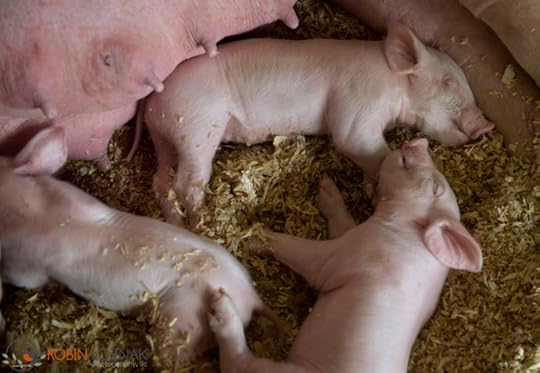 I’ll be at the fair all four days this year from 3 to 7 pm, highlighting my new book, The Shifting Winds, with copies also of A Place of Her Own.
I’ll be at the fair all four days this year from 3 to 7 pm, highlighting my new book, The Shifting Winds, with copies also of A Place of Her Own.
My friend A. Lynn Ash from my Eugene writing group will be there Wednesday and Thursday from 3 to 7 with her two travel memoirs, The Route from Cultlus Lake and her latest, Vagabonda. My friend Dianne Carter from my Roseburg writing group will be there all four days with her new debut novel, Misled, Wednesday through Friday from 11 to 3, and Saturday from 3 to 7.
Various members of An Association of Writers, my Roseburg group, will be at the Author Table throughout the four days from 11 in the morning until 7 in the evening. They’ll be selling member anthologies and inviting local writers to join the group. We’ll all be talking writing with whoever wants to chat.
So if you’re looking for cool at the Douglas County Fair this week, check out the Author Table, indoors, first left inside the main gate.
August 1, 2016
Bloomsbury Event Rescheduled
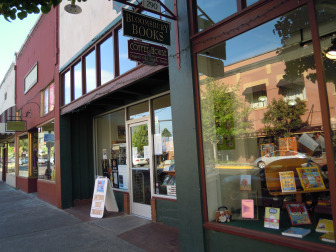 Just a note to let you know my book signing and reading event at Bloomsbury Books in Ashland has been rescheduled and will now be held on Monday, October 10 from 7 to 8 pm. I previously announced it in “News Briefs” as a September event, but realized it was the same night as the first Presidential Debate. Since that might affect attendance we moved the event ahead to the October date.
Just a note to let you know my book signing and reading event at Bloomsbury Books in Ashland has been rescheduled and will now be held on Monday, October 10 from 7 to 8 pm. I previously announced it in “News Briefs” as a September event, but realized it was the same night as the first Presidential Debate. Since that might affect attendance we moved the event ahead to the October date.
It’s always a pleasure to visit Ashland where I used to live back in the 90s. And Bloomsbury Books is a lovely store. Looking forward to it.


July 18, 2016
Book Event Explores a Living Past
Story and tangible history came together when the Friends of Fort Vancouver and the National Park Service hosted me for a book event at the remarkable re-creation of the historic Hudson’s Bay Company trading post, Fort Vancouver.
 The event highlighted the actual reconstructed fort with a tour led by Dr. Robert Cromwell, Chief Ranger and Archeologist, speaking behind the big gun here. Two large cannons stand in front of the elegant Big House, home of the fort’s commander in the days of my book, The Shifting Winds. During the tour I offered a few words on certain scenes from the book which took place at the fort in 1842 and 1843. I’m in the white hat. Photo by Robin Loznak.
The event highlighted the actual reconstructed fort with a tour led by Dr. Robert Cromwell, Chief Ranger and Archeologist, speaking behind the big gun here. Two large cannons stand in front of the elegant Big House, home of the fort’s commander in the days of my book, The Shifting Winds. During the tour I offered a few words on certain scenes from the book which took place at the fort in 1842 and 1843. I’m in the white hat. Photo by Robin Loznak.
The tour brought us into the fort’s living history, and Dr. Cromwell was great. I love this place that makes the past live. I feel a deep connection because my first visit here years ago inspired me to write The Shifting Winds, and making the past live is what I try to do with my historical novels.
 Dr. Cromwell talked about the impression the house would have made on its 19th century visitors, such a grand structure with its expensive white paint and the big guns facing the front gate, although he noted the guns were spiked so couldn’t fire.
Dr. Cromwell talked about the impression the house would have made on its 19th century visitors, such a grand structure with its expensive white paint and the big guns facing the front gate, although he noted the guns were spiked so couldn’t fire.
Nevertheless, the effect was no doubt intended to show the power of this British fur trading company that essentially ruled over Oregon at the time of my story.
I took the picture at left to show the grapevines draped over the Big House veranda on this July day and the bright flowers in front. You can also see part of the arbor in the top photo. On my previous visit in March the canes were bare, and no flowers yet bloomed. Now huge clusters of grapes hang from these lush vines.
Photos taken of the original Big House in 1860 let researchers know that grapevines twined around metal trellises on the veranda that extends across the entire front of the house.
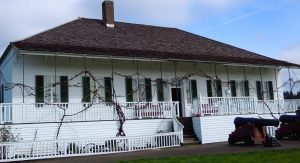 The thumbnail at right shows the house during my March visit before the greenery leafed out. Quite a change, and probably effective for the south-facing house. In winter when they needed more light the leafless vines let the sun come in, but in summer the leaves provided cooling shade.
The thumbnail at right shows the house during my March visit before the greenery leafed out. Quite a change, and probably effective for the south-facing house. In winter when they needed more light the leafless vines let the sun come in, but in summer the leaves provided cooling shade.
Our tour proceeded inside the house so the group could see additional settings of the story and learn more about the fort. Then we moved on to the Indian Trade Store and the Fur Store warehouse to get an idea of the real purpose of this fort. The Hudson’s Bay Company officers and employees may have appreciated the protection of the picketed stockade, but the fort never served as a military post for them. The Company came for the furs, particularly beaver, purely a business venture. But it could be a cutthroat business as they competed against the Americans, who also held an interest in the territory.
 The tour ended up at the New Office, above, the closest thing to the setting where my character Alan Radford would have worked. The clerk Alan lived and worked in the Old Office, which hasn’t been reconstructed yet. While Dr. Cromwell looked on, I talked about the scene where Alan invites protagonist Jennie to see his workplace during the Christmas Ball at the fort. Through a bit of byplay between these characters, I slip a little information into the story that gives the reader an idea how the fort functioned and how very isolated they were in this wilderness. Photo by Robin Loznak.
The tour ended up at the New Office, above, the closest thing to the setting where my character Alan Radford would have worked. The clerk Alan lived and worked in the Old Office, which hasn’t been reconstructed yet. While Dr. Cromwell looked on, I talked about the scene where Alan invites protagonist Jennie to see his workplace during the Christmas Ball at the fort. Through a bit of byplay between these characters, I slip a little information into the story that gives the reader an idea how the fort functioned and how very isolated they were in this wilderness. Photo by Robin Loznak.
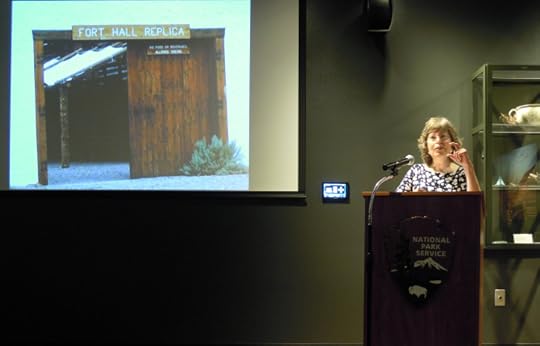 My lecture at the Visitor Center featured photos related to the story, this one showing Fort Hall, another reconstructed fort that became a landmark on the Oregon Trail. My thanks to Ranger and Guide Emily Orvis for setting up the AV tech equipment so it all rolled smoothly, and thanks to my son-in-law Robin Loznak for handling the individual photos while I talked. This shot of me was taken by Benjamin Capps with my camera.
My lecture at the Visitor Center featured photos related to the story, this one showing Fort Hall, another reconstructed fort that became a landmark on the Oregon Trail. My thanks to Ranger and Guide Emily Orvis for setting up the AV tech equipment so it all rolled smoothly, and thanks to my son-in-law Robin Loznak for handling the individual photos while I talked. This shot of me was taken by Benjamin Capps with my camera.
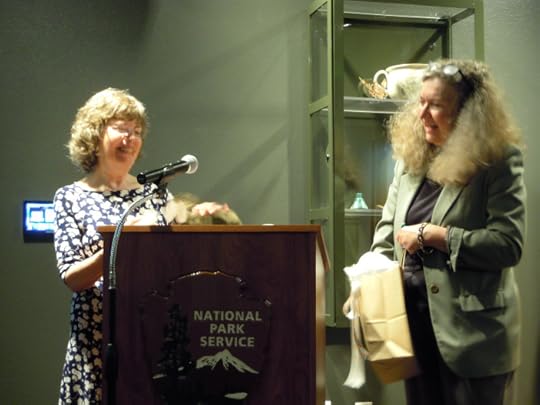 After my talk, Mary Rose, Executive Director of the Friends of Fort Vancouver, surprised me with a bag of thoughtful gifts, from a lovely turtle pin that memorializes the Native American label for the fort area as the “place of the mud turtles,” to Jacobsen sea salt from Oregon’s cold waters at Netarts Bay, to a Russian nesting doll acknowledging Vancouver’s many Russian immigrants, a little stuffed beaver representing the target of the 19th century fur traders, and a 100th anniversary pin commemorating the 100-year birthday of the National Park Service that maintains the site. What a delightful gesture! Photo by Benjamin Capps.
After my talk, Mary Rose, Executive Director of the Friends of Fort Vancouver, surprised me with a bag of thoughtful gifts, from a lovely turtle pin that memorializes the Native American label for the fort area as the “place of the mud turtles,” to Jacobsen sea salt from Oregon’s cold waters at Netarts Bay, to a Russian nesting doll acknowledging Vancouver’s many Russian immigrants, a little stuffed beaver representing the target of the 19th century fur traders, and a 100th anniversary pin commemorating the 100-year birthday of the National Park Service that maintains the site. What a delightful gesture! Photo by Benjamin Capps.
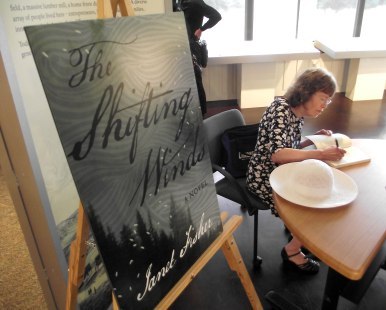 I arrived early, well before planned activities, which worked out. Tourists were stopping by and several bought my books, even some that hadn’t come for the event, and they were pleased to get personalized signed copies. My thanks to Sales Assistant Madya Panfilio for her enthusiasm in recommending my work. Official signing came after the lecture. Photo at left by Robin Loznak.
I arrived early, well before planned activities, which worked out. Tourists were stopping by and several bought my books, even some that hadn’t come for the event, and they were pleased to get personalized signed copies. My thanks to Sales Assistant Madya Panfilio for her enthusiasm in recommending my work. Official signing came after the lecture. Photo at left by Robin Loznak.
Mary Rose also asked me to sign additional books, which are available in the Visitor Center Bookstore.
Mary was the one who arranged my presentation at Fort Vancouver. When she learned about my book The Shifting Winds, she immediately became interested. She read the book, appreciated the accuracy and the story, and discussions led to Saturday’s presentation.
Many thanks to Mary for organizing such a wonderful event. She and the staff at the Visitor Center and the fort did a terrific job. Thanks to them all.
As my grandson Alex said, “They rolled out the red carpet for you, Grandma.” Yes, they did.
Everyone made it a wonderful day and I am most grateful.


July 14, 2016
The TRUE Shifting Winds ~ 6: Making the Past Live
My presentation in the Visitor Center at Fort Vancouver is just two days away, Saturday, July 16, and with this post I will close out the “TRUE Shifting Winds” series. The event starts at 2 pm, when I’ll give a talk while showing photos related to my book and the fort. I’ll do a couple of short readings from the book, selected from scenes at the fort, and after some Q&A, sign books.
The Visitor Center bookstore will have copies of The Shifting Winds for sale, and also my first book, A Place of Her Own, the story of my own great-great grandmother who came west over the Oregon Trail.
Following the signing I’ll invite attendees to go down to the fort where I’ll lead a tour of places that appear in The Shifting Winds, accompanied by Mary Rose, Executive Director of the Friends of Fort Vancouver. There’s a small fee to get into this National Park Service site, or if you have your own pass, that will work too. If you’re in the vicinity I hope you’ll join us for this walk into the past.
A Reconstructed Fort
Making the past live. Isn’t that what historical novelists do? Make the past live? We try. So we have something in common with those who worked so hard to bring structures and their contents back to life at Fort Vancouver. Even staff members put on the garb and help draw visitors back to an earlier time. And the rangers tell the old stories, like bards.
 We historical novelists tell the old stories through the eyes of our fictional and sometimes historic characters. For my part I’ll refer you to my book, The Shifting Winds, with its scenes in the Big House shown above, the Old Office, and the Bachelor’s Quarters, as well as the fort grounds and the dark orchard behind the stockade on a cold night.
We historical novelists tell the old stories through the eyes of our fictional and sometimes historic characters. For my part I’ll refer you to my book, The Shifting Winds, with its scenes in the Big House shown above, the Old Office, and the Bachelor’s Quarters, as well as the fort grounds and the dark orchard behind the stockade on a cold night.
Here in my post I offer photos taken on my recent visit to the fort—for illustration—with a little text and tidbits of history to enliven them.
The Big House
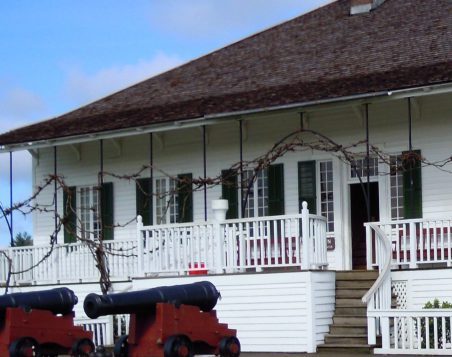 The preservation team didn’t have blueprints for the house. They knew what the outside looked like from pictures, but for the inside their only clues were snippets of descriptions and comparisons with managers’ houses at other HBC forts, plus the remains found by archeologists–footings, the base of the chimney, evidence of a cellar which probably held the oft mentioned wine and spirits served in the Mess Hall.
The preservation team didn’t have blueprints for the house. They knew what the outside looked like from pictures, but for the inside their only clues were snippets of descriptions and comparisons with managers’ houses at other HBC forts, plus the remains found by archeologists–footings, the base of the chimney, evidence of a cellar which probably held the oft mentioned wine and spirits served in the Mess Hall.
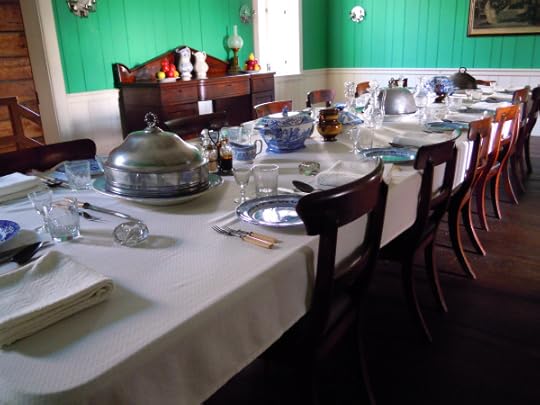 Gentlemen of the fort ate in the dining room in the Big House, generally called the Mess Hall, making this the center of business as well as social life. Everyone welcomed the arrival of visitors who brought news from other places, breaking the monotony of this isolated post. Many guests–distinguished and not–enjoyed the fine fare, even including soft loaf bread from the fort bakery, along with vegetables from the gardens, game from the hills, fish from the river, and eventually beef when herds grew large enough.
Gentlemen of the fort ate in the dining room in the Big House, generally called the Mess Hall, making this the center of business as well as social life. Everyone welcomed the arrival of visitors who brought news from other places, breaking the monotony of this isolated post. Many guests–distinguished and not–enjoyed the fine fare, even including soft loaf bread from the fort bakery, along with vegetables from the gardens, game from the hills, fish from the river, and eventually beef when herds grew large enough.
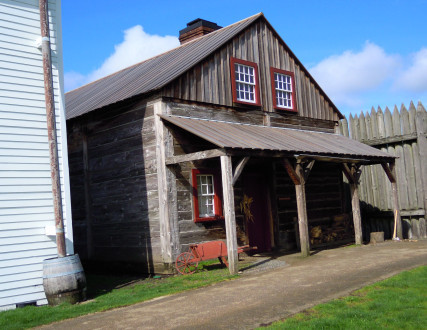 The well-stocked kitchen stood behind the house, connected by a passageway but separate for fire safety.
The well-stocked kitchen stood behind the house, connected by a passageway but separate for fire safety.
Gentlemen maintained careful military etiquette as to rank, although Chief Factor McLoughlin could use his discretion to make allowances for some, especially Americans, whose rank might be obscure. The officers of the fort offered the finest hospitality to keep visitors there as long as possible, although some of the gentlemen in the Bachelor’s Quarters, or even the office, might have to give up their rooms to house the guests.
 The McLoughlin sitting room, shown above, would be the place where Mrs. McLoughlin took her meals, sometimes with family and friends. Female guests with some status stayed in the Big House, like protagonist Jennie in my story, and she would have eaten her meals here with Mrs. McLoughlin. Only if the doctor missed mealtime in the Mess Hall might he join them.
The McLoughlin sitting room, shown above, would be the place where Mrs. McLoughlin took her meals, sometimes with family and friends. Female guests with some status stayed in the Big House, like protagonist Jennie in my story, and she would have eaten her meals here with Mrs. McLoughlin. Only if the doctor missed mealtime in the Mess Hall might he join them.
Most of the women, like Marguerite McLoughlin were at least half Native American. Her mother was Cree. The women wore European dress, but with moccasins and deerskin leggings for riding gentleman fashion, that is, astride.
People who saw the McLoughlin’s together often commented on the fondness they showed for each other, although some had trouble accepting fur trade marriages. One man made such a fuss, McLoughlin struck him with his gold-headed cane, later apologizing for his outburst. Soon afterward McLoughlin insisted on a civil marriage, and when he later returned to his Catholic faith, the couple was married again in a Catholic ceremony–by then thoroughly wed.
Johnson in his book John McLoughlin comments: “The deference that Mr. McLoughlin showed to his wife in public was the envy of all American wives, who lost no time in citing him to their husbands as an example worthy of emulation.”
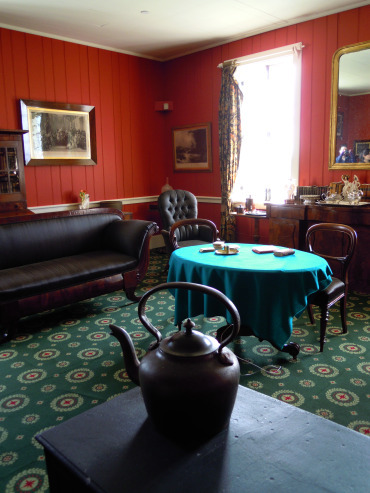 McLoughlin’s second-in-command, James Douglas, lived in the other half of the Big House at the time. The rich red of this room is based on a later detailed study conducted to determine the actual colors of rooms at the fort. Researchers perused books on the subject, visited other forts and inspected bits of painted wood and brick dug up by archeologists on the individual building sites.
McLoughlin’s second-in-command, James Douglas, lived in the other half of the Big House at the time. The rich red of this room is based on a later detailed study conducted to determine the actual colors of rooms at the fort. Researchers perused books on the subject, visited other forts and inspected bits of painted wood and brick dug up by archeologists on the individual building sites.
In their 2003 report they explain that this red was found on the east side of the building historically considered the side where the Douglas family lived. So the Douglas sitting room was painted red, a color gaining new popularity at the time.
Beige painted scraps were found on the opposite side, leading to the painting of the McLoughlin sitting room beige, a more conservative color, perhaps reflecting the doctor’s preference. The most common color found was green toward the back of the house, and that was interpreted as an appropriate color for the Mess Hall, the largest room on the main floor. Chair rails were common with the top sometimes painted the same as the bottom, sometimes not. Ceilings were usually white.
 Bedrooms tended to be in soft, pale colors.
Bedrooms tended to be in soft, pale colors.
 Dr. McLoughlin’s personal office, shown above, could be accessed from the McLoughlin sitting room, continuing the same rug design and wall color. His office can also be accessed from the main entryway of the house, on your left as you step in the door. A steep staircase rises directly ahead of the front door.
Dr. McLoughlin’s personal office, shown above, could be accessed from the McLoughlin sitting room, continuing the same rug design and wall color. His office can also be accessed from the main entryway of the house, on your left as you step in the door. A steep staircase rises directly ahead of the front door.
Some question arose as to the location of the ballroom cited in a number of writings of the time. One remarked: “had a ball in evening upstairs.” Could that have been the Mess Hall, up the long curving outdoor staircase to the veranda? Or would it be upstairs in the ample space between the main floor and the structure’s high roof? The Mess Hall could be the location of parties. Or perhaps a large hall in the long Bachelor’s Quarters.
Hussey in his report seems to lean toward the second story, despite the apparent lack of windows, and I happily adopted the site for the Christmas Ball. Unfortunately that room isn’t open to the public. Still, I had no trouble imagining it. Who needs much description of a vast room when you have candlelight and violin music and swirling dancers in grand ball gowns and dress coats and sparkling eyes?
The Bachelor’s Quarters
This long structure hasn’t been reconstructed yet, so I’ll let my character Jake give you a word picture for that from the pages of The Shifting Winds:
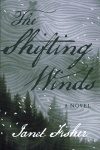 Jake glanced around the stark little room a Company officer had been compelled to give up for him. Company gentlemen might dress well, but they didn’t live so well. A small bed, a simple chest of drawers, a tiny table with a box for a chair, one trunk. That was it for furnishings. A few mementos hung on the walls—tomahawks, feathers, carvings, a couple of paintings.
Jake glanced around the stark little room a Company officer had been compelled to give up for him. Company gentlemen might dress well, but they didn’t live so well. A small bed, a simple chest of drawers, a tiny table with a box for a chair, one trunk. That was it for furnishings. A few mementos hung on the walls—tomahawks, feathers, carvings, a couple of paintings.
Like most of the fort buildings, the Bachelor’s Quarters were constructed in the Canadian post-on-sill fashion with sills of heavy, square-sawn timbers lying horizontally between upright grooved posts. Not a bit of paint on the unlined walls. But they did have glass windows.
He peered through the glass at the Big House where they were holding tonight’s party.
The Office
As noted in my last post, only the New Office has been reconstructed, although the Old Office may yet be built because it still stood on the fort grounds in 1845, even after they completed the new. The clerks couldn’t move into the new one because the captain of a visiting ship had taken up residence there.
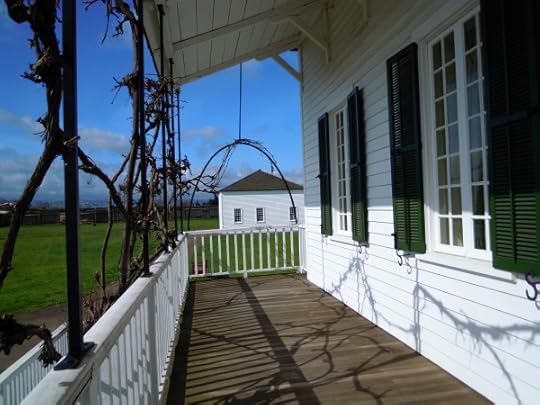 The New Office can be seen now from the veranda of the Big House, but the Old Office and another building would have partially blocked the view.
The New Office can be seen now from the veranda of the Big House, but the Old Office and another building would have partially blocked the view.
The office was the domain of my character, the handsome clerk Alan Radford. I have a scene there when he invites protagonist Jennie to see where he works, offering her a glimpse of his life. He might have worked at a desk like the one, below left, part of the furnishings in the reconstructed New Office. Another brief word picture from The Shifting Winds:
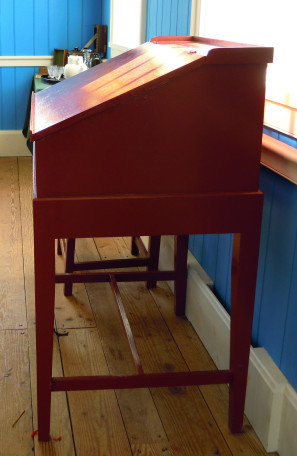 “So,” Alan said with a sweeping gesture to embrace the room, “my quarters, my place of work, and the hub of business at Fort Vancouver. What do you think?”
“So,” Alan said with a sweeping gesture to embrace the room, “my quarters, my place of work, and the hub of business at Fort Vancouver. What do you think?”
Caught up in his enthusiasm, she laughed. “It looks very . . . businesslike.”
Stark, but neat and orderly, the room had only two tall desks surrounded with several tall stools, the desks piled with books and ledgers and paper tidily stacked, ink bottles and rulers and pens beside them. . . .
Alan took her arm and led her to one of the desks. Laying a hand on the desktop, he gave her a warm smile. “My desk. I spend a lot of time here.” He lifted a large black book and handed it to her. “Journals. We have to keep daily journals of everything that happens around here—what the men are doing, what the weather is like, who comes and goes.” He raised his brows, eyes alight. “You yourself will be in here, my dear. . . . You know, we almost have to see into the future here when we make our indents.”
“What are indents?”
“Our requests for supplies. The whole process takes so long that—well . . . here it is the end of 1842, and the lists we make now are for the year 1846.”
“Really? Why?”
His eyes smiled, and he swept one arm wide, his voice suddenly charged with drama. “It pleases me you want hear of my travails, m’lady.”
She laughed at his pretense and went along with it. “Kind sir, I want to know everything about you.”
“Ooh. That’s rich. Are you quite sure, m’lady, that you want to know it all?”
More Glimpses of the Past
 From the front door of the Big House you can look out on the working Blacksmith Shop at left and the well-stocked Indian Trade Store, straight ahead. Interiors below.
From the front door of the Big House you can look out on the working Blacksmith Shop at left and the well-stocked Indian Trade Store, straight ahead. Interiors below.

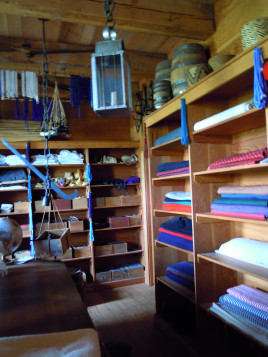 As noted in the previous post the Indian Trade Store was moved to this location sometime after my story. At the time of my story it was located across the grounds to the west.
As noted in the previous post the Indian Trade Store was moved to this location sometime after my story. At the time of my story it was located across the grounds to the west.
 The Fur Store, shown above, stands on that spot today.
The Fur Store, shown above, stands on that spot today.
These are some of the places we’ll see on Saturday when we tour the post, getting a glimpse into a past where people from my book walked, while stepping on ground where a historic character from the book actually trod, the fascinating Dr. John McLoughlin. And so through the creation of story and re-creation of this wonderful fort we endeavor to make the past live.
Thank you for joining me here. If you can, I hope you’ll join me at the fort.
Sources:
Hussey, John A. Historical Structures Report Historical Data, Vol. I and II. Denver Service Center, National Park Service, U.S. Department of the Interior, 1972, 1976.
Johnson, Robert C. John McLoughlin: “Father of Oregon.” Portland, OR: Binfords & Mort, 1958.
Langford, Theresa, Scott Langford, and David K. Hansen. Paint at Fort Vancouver National Historic Site: Historical and Archaeological References for Interpretation and Reconstruction. Vancouver, WA: Department of the Interior, National Park Service, Fort Vancouver National Historic Site, 2003.


July 12, 2016
The TRUE Shifting Winds ~ 5: Digging Up the Past
I first visited Fort Vancouver some years ago to research a short segment for one of my early attempts at an Oregon Trail novel, and the place put me right back in time. I was so inspired by the authentic reproduction of this historic fort I knew I had to write another book with more scenes set there. That became The Shifting Winds, which I’m honored to be presenting at the fort this Saturday, July 16, at 2 pm.
In this post I want to talk about how this wonderful reconstruction came to be.
Archaeology and Record Keepers
The British Hudson’s Bay Company chose a location on the north bank of the Columbia River for their western headquarters in the Oregon Country because they felt optimistic about Britain holding land on that side of the river once London and Washington agreed on a boundary between the two nations. But in 1824 when Dr. John McLoughlin and his boss Governor George Simpson selected the site, enough uncertainty hung over the region that they didn’t want to make a huge investment.
Also unsure of the friendliness of the local tribes, they erected the first palisade walls about a mile inland, creating a simple fur trading post on a bluff about a mile from the river with bastions on at least two corners, ready to defend themselves against attack.
Several events came together to change their perspective. First, the joint occupancy treaty of 1818 between the British and the United States was extended indefinitely in 1827. The Native Americans proved to be agreeable traders, and the distance from the river proved to be a bloody nuisance.
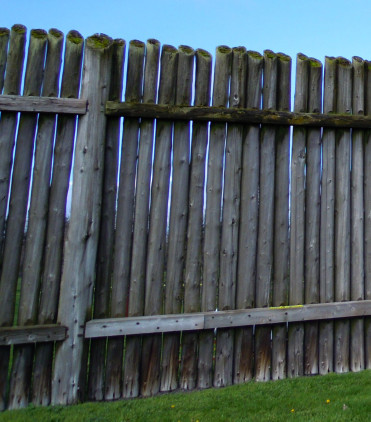 So in 1828 they pulled up stakes, literally, and moved the whole thing a mile closer to the river to the spot where the reconstructed fort lies today.
So in 1828 they pulled up stakes, literally, and moved the whole thing a mile closer to the river to the spot where the reconstructed fort lies today.
Christened in 1829, the new fort would serve the Company for many years. But it didn’t remain static. It kept changing over time like a living, breathing organism that sloughs off old skin while growing new. The fort walls kept moving.
The fort doubled in size by 1836. Apparently the officers found their space too small. They would expand again, moving the south wall farther out—and the east wall—again.
Buildings changed. The first Big House in the original west half began to sag until someone described its condition as so dilapidated it was ready to fall down around them. They rebuilt a new Big House in the east half where you can see it reconstructed today.
So why the reconstruction? Why did the original disappear? And why the constant change?
In short, wood rots—especially in a place where rain soaks the land for more than half the year. And little critters move in to feed on wood fiber.
Constant maintenance was required, and sometimes they just tore down buildings and constructed new. They continually replaced rotting pickets in the stockade and repaired leaky roofs. When the British finally lost the land on which the fort stood—as you must know they did—the Hudson’s Bay Company was allowed to stay on for a while, but they soon began moving the bulk of their business to Fort Victoria. London and Washington had finally agreed on a border in 1846, drawing the line along the 49th parallel, well north of Fort Vancouver, although giving the British Victoria along with the entirety of Vancouver Island.
By 1860 the Company abandoned the fort and the United States Army assumed control. But they found most of the buildings unsuitable for their purposes and in dilapidated condition. In a few years rot and fire destroyed what was left.
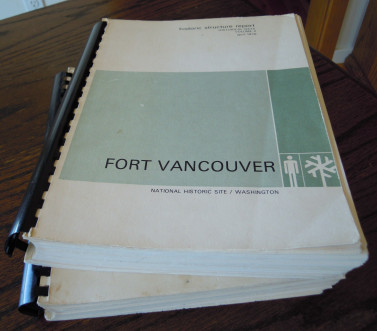 Yet some historians did not forget. And in the 1940s the National Park Service began exploring the possibility of reconstruction. If they were going to do it they wanted to do it right.
Yet some historians did not forget. And in the 1940s the National Park Service began exploring the possibility of reconstruction. If they were going to do it they wanted to do it right.
On my first visit to the reconstructed fort in the 1980s a curator there loaned me these two large volumes of a “Historic Structures Report” by John A. Hussey and the historic preservation team. The volumes described the detailed research that went into this re-creation, a wealth of information. When I called about returning the volumes, the curator told me that if I continued to find them useful I should keep them because they had plenty of copies. What a boon to my research!
Now of course the report is online, offering a glimpse of the magnitude of the project. But I have spent many hours poring over the printed books.
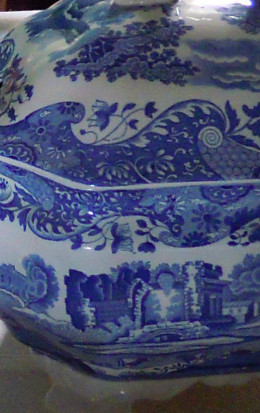 As early as 1947 National Park Service archeologists dug into the soil to find footings of buildings and remains of those moving walls at their various locations. They found tools, pottery, even Spode china on the site of the Big House–something in blue on white, perhaps to match these on display in the Big House dining hall, or Mess Hall, like the one at right. Meanwhile, researchers looked into records. The Hudson’s Bay Company, still a functioning business in the UK, generously opened their remarkable archives for this study. The British had kept detailed records.
As early as 1947 National Park Service archeologists dug into the soil to find footings of buildings and remains of those moving walls at their various locations. They found tools, pottery, even Spode china on the site of the Big House–something in blue on white, perhaps to match these on display in the Big House dining hall, or Mess Hall, like the one at right. Meanwhile, researchers looked into records. The Hudson’s Bay Company, still a functioning business in the UK, generously opened their remarkable archives for this study. The British had kept detailed records.
Researchers were also given access to similar HBC posts, now in Canada, and those were studied and photographed for comparison. The Company tended to follow similar plans from one fort to another, so those helped in decisions about the finer points.
Books written in the day offered observations of the fort. Libraries across the United States and Canada held useful tidbits. Many fort visitors wrote about their impressions, sometimes drawing detailed sketches and maps. These were often dated and helped show the constant rearrangements going on over the fort’s life. Researchers scrutinized maps, drawings, every descriptive statement they could find. Much of that went into this report, along with bits of story that add flavor.
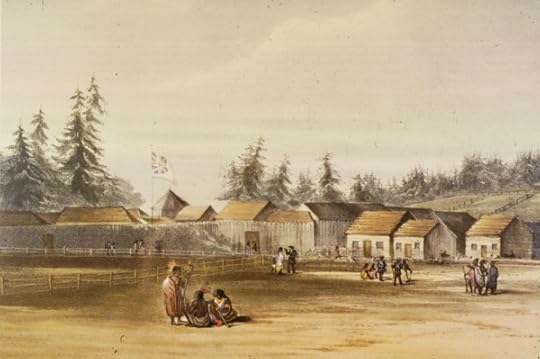 The above lithograph was based on a water color by Henry J. Warre painted during his 1845 visit. My thanks to Meagan Huff, assistant curator at the fort, for sending me this copy from the National Park Service collection. She pointed out a change the artists in London made to Warre’s original. Perhaps wanting the image more colorful they replaced the original figures in the foreground with Native Americans, but in Plains tribe dress, not realizing that these tribes did not frequent the area.
The above lithograph was based on a water color by Henry J. Warre painted during his 1845 visit. My thanks to Meagan Huff, assistant curator at the fort, for sending me this copy from the National Park Service collection. She pointed out a change the artists in London made to Warre’s original. Perhaps wanting the image more colorful they replaced the original figures in the foreground with Native Americans, but in Plains tribe dress, not realizing that these tribes did not frequent the area.
 Warre gave us the characters at left. Perhaps shepherds? Or voyageurs?
Warre gave us the characters at left. Perhaps shepherds? Or voyageurs?
Because the fort changed so much from year to year, the preservation team needed to pick a date, and they decided to reconstruct to the year 1845. That’s close to the date of my novel, which has scenes at the fort in 1842 and 1843. So as I read the report I had to make careful distinctions between the 1845 fort I saw and the 1842 fort I would describe.
For instance, in one scene Dr. McLoughlin and my fictional clerk Alan walk across the grounds from the Big House to the Indian Trade Store in the western courtyard. Today you’ll find that store on the east side, almost straight across from the Big House, a short walk. But in 1842 that store was over in the western side where the Fur Store stands today. A longer stroll.
Perhaps the most conspicuous difference would be the bastion you can see in Warre’s 1845 image above. There was no bastion in 1842, so you won’t find reference to a bastion in the book. But I have shown it in blog and Facebook posts because it looks so fort-like. Fort Vancouver was more trading post and supply depot than fortress. Caution required walls but not big guns.
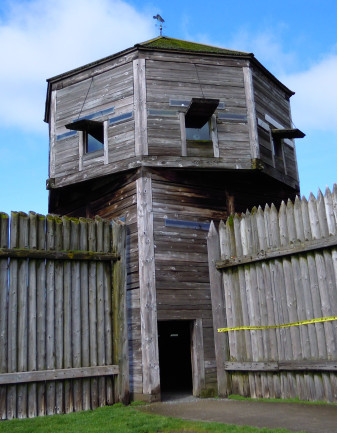 The bastion went up in 1844, not because of danger, but because of protocol. Hussey relays the story in the report. A ship sailed up the Columbia in 1844 and offered a 7-gun salute. But the fort couldn’t answer the salute because they had no cannons mounted for action. Although they’d put up bastions on the old fort, they hadn’t bothered with a bastion in the new fort, things being so peaceful.
The bastion went up in 1844, not because of danger, but because of protocol. Hussey relays the story in the report. A ship sailed up the Columbia in 1844 and offered a 7-gun salute. But the fort couldn’t answer the salute because they had no cannons mounted for action. Although they’d put up bastions on the old fort, they hadn’t bothered with a bastion in the new fort, things being so peaceful.
But not to be able to answer a salute—well, that just wouldn’t do. So they built one. And given the troublesome nature of some of the pesky Americans coming into the country it seemed a good idea anyway.
Another change was the New Office, built in 1845 to replace the Old Office. The Old Office was one of the oldest buildings of the fort, the first thing constructed, given its function so vital to the fort’s purpose. That Old Office still served the fort in 1845, because the new one offered temporary living quarters for a ship captain who stayed on for a while, adding excitement for the gentlemen with his many parties in the new structure. This New Office, or “Counting House” as it was sometimes called, has been reconstructed. The Old Office has not, although perhaps one day it will be. It stood close by its replacement at least until 1847 when the good captain departed. The old building with its dark exterior shows clearly in a water color sketch drawn in 1846 or 1847.
The fort required considerable bookkeeping. Clerks like my fictional Alan Radford generally entered service through apprenticeship, nearly all of them from Britain. Because of the many applicants, family connections helped. These clerks were usually well educated and knew some accounting beforehand. The Company wanted reliable, loyal clerks working in the office, men who would be discreet and keep Company business confidential. These accounting clerks held one of the better paid jobs for gentlemen at the fort.
I took particular interest in the office, given that Alan is a major player in my book. Other buildings of special interest to me were the Big House where Jennie stays during her visit for the Christmas Ball and where the ball takes place, and the Bachelor’s Quarters where American mountain man Jake Johnston stays, having joined the party for his own reasons. Accountants like Alan lived in the office, but most clerks lived in the Bachelor’s Quarters, a long building divided into multiple rooms or apartments. And when gentlemen came to visit, the clerks often got bumped to accommodate the visitors.
However, Alan appeared none too pleased when McLoughlin allowed Jake a room in the Bachelor’s Quarters. When Jennie asked Jake what was wrong with Alan, Jake grinned.
“Well,” he said, “it’s only gentlemen who are allowed to stay inside the fort, and I don’t think Radford considers me a gentleman.”
She wasn’t sure Jake was a gentleman either, but she was surprised at the rigidity.
The Bachelor’s Quarters have not been reconstructed yet either, but the report offers excellent detail.
Hussey, John A. Historical Structures Report Historical Data, Vol. I and II. Denver Service Center, National Park Service, U.S. Department of the Interior. 1972, 1976.
Next: Making the Past Live


July 10, 2016
The TRUE Shifting Winds ~ 4: British Stronghold
So enters the venerable Dr. John McLoughlin onto our Oregon stage, just six years after the 1818 treaty which declared that the United States and Britain should jointly occupy the Oregon territory until they could stop bickering and agree on a line between them in that disputed land.
In this overview of history behind my story in the historical novel The Shifting Winds, we nudge ever closer to the volatile contention between these two nations that resonates through the book’s pages.
Dr. McLoughlin’s Oregon Reign
As mentioned in the last post, the Canadian North West Company, which had bought the US Fort Astoria, stayed on at the post despite terms of the 1814 Treaty of Ghent that ended the War of 1812. Due to the remoteness of this fort at the mouth of the Columbia River, negotiators didn’t know about the sale, and the fort came under terms that all property taken during the war be restored to the original possessor. The restoration became a murky point of history.
 Whatever the case, when Dr. McLoughlin of the British Hudson’s Bay Company comes onstage, his company has assumed possession by default of Fort Astoria, now called Fort George by the British in honor of their king.
Whatever the case, when Dr. McLoughlin of the British Hudson’s Bay Company comes onstage, his company has assumed possession by default of Fort Astoria, now called Fort George by the British in honor of their king.
The British knew how to make an entry.
The daguerreotype at right shows McLoughlin when he’s a little older than the day he first arrived at Fort George, but he carried himself with this powerful presence throughout his career. Photo courtesy of the National Park Service.
McLoughlin arrived at Fort George in full color display in a line of brightly decorated canoes along with his boss, Deputy Governor of the HBC, George Simpson.
Author Johnson describes the scene in his book John McLoughlin. As the flotilla of canoes approached, a sentry at the fort fired a signal gun. From the flotilla a bugle answered, followed by a piper in full Highland dress playing a march of the clans, “‘Si Coma Leum Cradh Na Shee,’ (Peace if you will it, otherwise war).”
The fort responded with a seven-gun salute.
The piper played until the paddlers brought Simpson’s lead canoe to a stop. Then the bugler in McLoughlin’s canoe played a lively chanson. The canoes formed a line offshore, made a smart turn toward the receiving party, then moved as one toward the landing, where the men embarked and joined a procession with McLoughlin and Simpson in the lead.
Many old friends in the fur trade welcomed McLoughlin, a formidable figure in stark contrast to his superior officer, Simpson. McLoughlin was six foot four, well built, his hair almost white even then at the age of 40. His piercing gray-blue eyes could rivet on a person, his clean-shaven face readily turning florid with anger or excitement. Simpson was just over five feet and plump.
Back in 1803 at age 14 McLoughlin had become a medical student in Quebec and obtained a license to practice medicine and surgery when he was all of 19.
Author Johnson relays a story of uncertain merit about McLoughlin that may have changed the direction of his life. While working as a doctor in Quebec, McLoughlin is said to have been walking with a young lady through the muddy streets of that city on a fine spring day. They stepped onto a plank at an intersection to avoid the mud, and a drunken British officer forced the young lady off the plank into the muck. McLoughlin picked up the officer and tossed him into the street.
This insult on “his majesty’s uniform” could have subjected McLoughlin to prosecution, and he supposedly fled into upper Canada.
Whether this incident or something else drew McLoughlin away from Quebec, he found employment as a physician at Fort Williams, a North West Company trading post. McLoughlin soon discovered he had an aptitude for business, and by 1814 he became a partner in the company. Still, he would find his medical skills valuable more than once when he worked at posts with no other doctor.
Somewhere in there, he had a son through a liaison with a Native American woman, “observing the custom of the country,” Johnson writes, meaning the relationship like so many others in that time and place lacked the benefit of clergy, also called a “country marriage” or “fur trade marriage.” Evidently the mother died and McLoughlin took another wife in the custom of the country, Marguerite Wadin McKay, a woman who would follow him to Oregon and happily grow old with him.
Marguerite’s father was one of the original North West Company partners, her mother of Cree heritage. She had previously married Alexander McKay, a Canadian member of Astor’s team who was killed in an incident on Astor’s ship, the Tonquin. Given the dates of events, McKay had probably abandoned her by the time she married McLoughlin, but she had three children by McKay, including Tom McKay who would come to play a significant role in the history of the Oregon country. By the time McLoughlin left for Oregon he and Marguerite had four children together.
Fort George didn’t impress McLoughlin or Simpson as an adequate western headquarters for the Hudson’s Bay Company, a major problem being its location on the south side of the river. From word of London’s offers in boundary negotiations, they feared that everything south of the Columbia River would ultimately go to the Americans. McLoughlin also wanted to make his headquarters as self-sufficient as possible, so he needed fertile land to grow food.

Nancy Funk, wearing period clothing, takes care of a garden at the Fort Vancouver National Historic Site in Vancouver, Washington. (Troy Wayrynen/picturesbytroy). Photo courtesy of the National Park Service.
Going upstream, McLoughlin found a site on the north bank that offered all he had hoped for. A rich wide plain spread inland from the river. Here he could grow wheat and vegetables, fruit orchards and vineyards, and improve pasture for cattle. He ordered his men to start building a fort and dubbed it Fort Vancouver for the British navigator Captain George Vancouver who’d sent one of his ships up the Columbia shortly after the American Captain Robert Gray dipped into the estuary and named the river. McLoughlin was happy to note that the site of his new fort lay downriver from the highest ascent of the British ship. McLoughlin would soon have the original stockade moved closer to the river for convenience. And from that fort, which has been replicated on the same spot today, he ran the western fur trade empire for his Company, becoming de facto ruler of Oregon.
It might have seemed his land to hold, but not quite so. By treaty the United States held equal interest through joint occupancy. Their citizens just weren’t around much at the beginning.
Joint occupancy of the Oregon country formed a tenuous marriage of Britain and the United States. Both had sought to claim the land. By sea, their navigators explored the coast, with the American guy discovering and naming the Columbia, the British guy sailing farther upstream. By land, Lewis and Clark showed the way through the new US territory of Louisiana, while the Canadian Mackenzie marked a trail farther to the north. And when Astor ventured into the Columbia to start his fur enterprise, the Canadian Thompson trekked out to Fort Astoria to say hello and set up posts along his route, eventually acquiring Astor’s fort for his own North West Company.
Fighting fury between the two nations rose in the War of 1812 for a host of reasons, but Oregon was a prize both still sought. Negotiators for peace finally threw up their hands. It took a second treaty in 1818 to come up with a halfway measure, at which time negotiators told the squabbling nations they could both use the land until they made up and set a line between them. They were given ten years for that, but in the end it would take them almost thirty, and rumors of another war over the matter continued to stir.
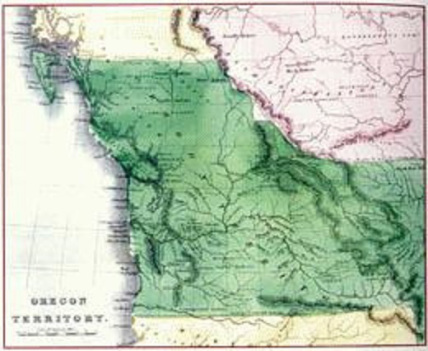 The 1833 map at right roughly shows the extent of the Oregon territory in 1818. It includes all of today’s Oregon, Washington, and Idaho, with parts of Montana and Wyoming, and runs north into British Columbia.
The 1833 map at right roughly shows the extent of the Oregon territory in 1818. It includes all of today’s Oregon, Washington, and Idaho, with parts of Montana and Wyoming, and runs north into British Columbia.
For twenty years or so while the United States became attracted to other shiny objects closer to home, the powerful British Hudson’s Bay Company seemed bent on making Oregon their own private fur reserve under McLoughlin’s adept leadership.
By 1842 when my story opens, the Americans seemed finally to awaken to the desirability of adding the Oregon country to their own. American trappers began to settle in Oregon’s broad valleys around 1840 when the Rocky Mountain fur trade petered out. Missionaries had gone out to save the Indians in the 30s and reported on the richness of the land. Promoters called on the adventurous to strike out across the plains and take up some of that land virtually flowing with milk and honey. They played down the difficulty of the trail–most hadn’t a clue–as they extolled the wonders of the Promised Land at trail’s end.
Native Americans received little consideration. Disease had dramatically reduced their numbers, and the British under McLoughlin’s firm hand kept the peace. Trade with the local tribes was key to the business operation of the HBC.
As more Americans trickled into the area, tensions rose. American farmers and lawyers and storekeepers came with their families, intending to settle and stay. Settlement hadn’t been encouraged by the British during the early days of joint occupancy, but they did eventually encourage settlement north of the Columbia as a counterbalance. Up until that time few white women came to Fort Vancouver. British and French-Canadian men found their wives among the surrounding tribes, or brought their Native American or Métis wives from Canada. Most expected to return to the place they had enlisted with the Company, though a few had chosen to settle in the Willamette Valley, McLoughlin keeping them on the Company books so they didn’t have to go.
The encroachment of permanent US settlers into Oregon brought troubling headaches for the good doctor, McLoughlin.
Carey, Charles H., LLD. General History of Oregon: Through Early Statehood. Portland, OR: Binfords & Mort, 1971.
Johnson, Robert C. John McLoughlin: “Father of Oregon.” Portland, OR: Binfords & Mort, 1958.
Various websites.
Next: Digging Up the Past


July 8, 2016
The TRUE Shifting Winds ~ 3: Mountain Men
This third in a series of posts leading to my July 16 Fort Vancouver event looks at the American side of the fur trade at about the time Dr. John McLoughlin was sent to take charge of the Columbia District for his employer, the honorable British Hudson’s Bay Company. The Astor venture, having failed for the Americans, left the United States without much footing in the Columbia, but fur trade prospects had already begun brewing for the Americans in another arena, the Rocky Mountains on the edge of their now undisputed Louisiana Territory.
Before I focus on that American trade directed by St. Louis companies, I want to present a painting and go back to that young man I mentioned in post number 2, John Colter, a member of the historic Lewis and Clark expedition.
The American Scheme
The painting below by modern-day artist Andy Thomas of Carthage, Missouri, represents John Colter. Thomas calls the image “First Mountain Man.” This artist offers many paintings of historic people and events, and his mountain man appealed to me.
 I was looking online for photos to represent my characters when I came across it.
I was looking online for photos to represent my characters when I came across it.
I wanted to put together a poster and banner with images portraying my protagonist, American pioneer Jennie Haviland, and the two men in Oregon who were vying for her affections, British Hudson’s Bay Company clerk Alan Radford, and American mountain man Jake Johnston.
Alan was a well-dressed gentleman of the times and I had no trouble finding an 1800s fashion plate that had the right look, complete with frock coat and tall beaver hat, even if the face wasn’t quite as gorgeous as I imagined him. And I found a young woman in a fashion plate with period dress, her face hidden by a bonnet so folks can imagine her appearance as they choose.
But there were no fashion plates for mountain men. Most of the mountain man pictures I found were of crusty old fellows with long, scraggly beards. Now, there may have been some mountaineers like them, but trapping in the Rockies was not a business for old men. These guys had to be tough and in their prime, and most were clean shaven.
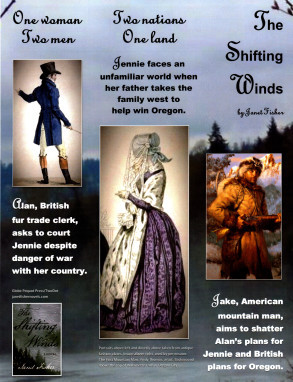 Part of the reason for shaving was that the Native American men they associated with had little face hair and plucked what grew, so the women seeing a bearded white man might laugh disparagingly and call him a dog face. If these trappers wanted to win the hearts of these women, shaving was a good idea–not to mention the greater ease of keeping small critters out of their soup.
Part of the reason for shaving was that the Native American men they associated with had little face hair and plucked what grew, so the women seeing a bearded white man might laugh disparagingly and call him a dog face. If these trappers wanted to win the hearts of these women, shaving was a good idea–not to mention the greater ease of keeping small critters out of their soup.
Anyway, I came across this image, and it spoke to me. The guy in the painting had the gravitas I was looking for, and with the artist’s permission, John Colter now plays the role of Jake for me on the poster shown at right, on a larger horizontal banner, and in other marketing materials for the book.
He doesn’t look exactly the way I see Jake either, but he has keen eyes that might be about to twinkle and a bit of don’t-mess-with-me attitude I can’t help but like. He’ll probably shave when he gets back to camp.
And that brings us to the real John Colter. He was born in Virginia sometime around 1775, his father evidently having come from Ireland. The family moved to the Kentucky frontier around 1780 when John was a young boy. At about 30 years of age he impressed Meriwether Lewis with his frontier skills, and Lewis recruited him for the Lewis and Clark Expedition as a private .
Colter may have been a little hotheaded because he got into a fracas with his sergeant even before they left and threatened to shoot the man, but somehow it got smoothed over and he became a valued member of the team and one of the best hunters. Lewis learned he could trust Colter to handle many difficult situations. The man showed skill in bartering with the tribes they met, and he would strike out alone wherever Lewis or Clark asked him to go and always find his way.
Two months before the end of the journey home, the expedition met some trappers headed west, and Colter joined them as a worthy addition, given his fresh knowledge of much of the territory. He went out alone for them during the winter, traveling some 500 miles through the wilderness to establish trade with the Crow nation, and was probably the first white man to see such sights as the spewing Yellowstone wonders, which came to be known as Colter’s Hell. Many stories of his skills and scrapes have been the stuff of books and movies, but probably none so dramatic as his run from the Blackfeet.
Colter was canoeing up the Jefferson River with another trapper Potts when several hundred Blackfeet showed up and demanded the two go ashore. The Blackfeet killed Potts in the incident, hacking him to death, then stripped Colter naked and told him to run. He soon realized they expected him to run for his life. His nose began to bleed, but he kept going as blood streamed and was well ahead of all but one of his pursuers.
With a suddenness that startled the man on his tail, Colter came to an abrupt stop and swung around to face him, arms wide. Caught by surprise at Colter’s actions, and perhaps the blood streaming over Colter’s naked body, the man also tried to stop but fell forward as he threw a spear and plunged it into the ground. Colter snatched up the broken weapon and killed him, then grabbed a blanket from him and fled the others. After a five-mile run he reached the Madison River and jumped in, taking refuge in a beaver lodge until nightfall when he escaped.
Thus he became something of a legend. When he did return to civilization a few years later he visited William Clark of the Lewis and Clark expedition and reported on his travels, adding considerable detail for Clark’s maps. He got married and farmed in Missouri awhile before fighting in the War of 1812. He never returned to the mountains.
About ten years after the war, just before Dr. John McLoughlin went out to the Columbia, some men of St. Louis, William Ashley and Andrew Henry, put together a fur company that significantly impacted the American fur trade. Prior to that time, most furs were acquired through trade with the Indians. But Ashley and Henry led their own trappers into the west, where they built a couple of forts and wintered with the Crow tribe. In the spring of 1824 the trappers went into the Green River country and found it rich in beaver. Ashley came up with a working scheme when he put together the first supply train and took the caravan to the Rockies the next summer so the trappers didn’t have to haul their furs to market in St. Louis. The annual rendezvous had begun.
 The above painting by Alfred Jacob Miller shows the supply caravan bringing supplies to the Rocky Mountains for the annual rendezvous of the mountain men. Miller went out with the supply train in 1837 and created many portraits of the landscapes and mountaineers and Native Americans he saw there. The man on the white horse is the Scottish adventurer William Drummond Stewart who hired Miller to take the journey with him to record the event.
The above painting by Alfred Jacob Miller shows the supply caravan bringing supplies to the Rocky Mountains for the annual rendezvous of the mountain men. Miller went out with the supply train in 1837 and created many portraits of the landscapes and mountaineers and Native Americans he saw there. The man on the white horse is the Scottish adventurer William Drummond Stewart who hired Miller to take the journey with him to record the event.
The Rocky Mountain Rendezvous lasted from 1825 until 1840 when beaver began to play out and prices dropped because men discovered silk hats to replace their beavers. It was a great run and the rendezvous an uproarious party when men let loose after they’d spent a year working hard in dangerous conditions. The supply trains brought out pure alcohol to mix with the clear water of the mountain streams, adding to the craziness. Friendly tribes gathered with the mountaineers, and many of the Americans took wives from these tribes or enjoyed temporary liaisons.
 This Miller portrait shows the rip roaring greeting trappers typically gave to the arriving caravan. Again the Scot Stewart is on the white horse.
This Miller portrait shows the rip roaring greeting trappers typically gave to the arriving caravan. Again the Scot Stewart is on the white horse.
During these years the Americans pretty well kept to the Rockies, while the British reaped the Oregon Territory of beaver there. Sometimes they bumped up against each other, and competition was fierce. The British ultimately pursued a scorched earth policy to make sure there weren’t enough beaver left on the west side to lure the Americans to Oregon.
Because of the supply train system many of the American trappers never went back home, and after years of living in the wilderness, often with wives and children they knew wouldn’t be accepted in the States, they felt adrift when the mountain life ended. So after the last rendezvous of 1840 quite a few went to Oregon anyway and decided to become settlers, a situation that didn’t always set well with the British. Thus legendary mountain man Joe Meek, a major player in my book, enters the stage, along with others who are named in the pages, accompanied by the fictional Jake Johnston. This was just two years before the book’s 1842 opening.
Dr. McLoughlin, another major historic player in my book, found himself caught in a dilemma between honoring the interests of his nation and following his own humanitarian instincts.
But when the good doctor first went to the Oregon Country in 1824 the British had a near monopoly there and prospects all looked rosy.
Gowans, Fred R. Rocky Mountain Rendezvous: A History of the Fur Trade Rendezvous 1825-1840. Provo, UT: Brigham Young University Press, 1976.
Various websites.
Next: British Stronghold


July 5, 2016
The TRUE Shifting Winds ~ 2: Fur Traders
As my upcoming July 16 book event at Fort Vancouver nears, this new blog series sets the stage for that historic place and the part it plays in my book The Shifting Winds.
The overview of the true history of the world’s shifting winds continues in this post as the unknown Pacific Northwest keeps luring explorers into the region. Of course, mere curiosity would not compel them like the hopes of gaining a new possession and the riches the land offered. While the glitter of gold may have drawn earlier navigators like the Spanish and Portuguese to the centers of their discoveries, another prize put a gleam in men’s eyes and prompted a race to win the Pacific Northwest territory.
The prime fur was beaver like these pelts at right displayed in the reconstructed Fort Vancouver warehouse. Without the fur, Fort Vancouver would not have been. This was the chief bounty, thanks to the beaver hat which became a popular fashion statement in Europe and the States, as traders from two nations pressed for advantage in one land.
The Race for Possession
Thomas Jefferson had been interested in the Pacific Northwest for some time when he took office as President of the United States in 1801, but without a contiguous territory overland he was not ready to consider more than an independent state in the region. Even that he considered to be a hazardous endeavor for the young nation.
 This 1794 double hemisphere wall map of the world, or terraqueouis globe, by Samuel Dunn shows the new discoveries and marginal delineations. From Geographicus.
This 1794 double hemisphere wall map of the world, or terraqueouis globe, by Samuel Dunn shows the new discoveries and marginal delineations. From Geographicus.
So the maps they are a-changing. It’s beginning to look more familiar.
Jefferson was intrigued by the 1765 report of Major Robert Rogers, who had written of a great “River of the West, or Ouragon River” said to flow west into the Pacific Ocean, a potential northwest passage from the Atlantic to the Pacific. And by 1792 the US navigator Captain Robert Gray had already discovered and named the Columbia River. Soon afterward British Lieutenant William Broughton, under the command of Captain George Vancouver, had sailed some 120 miles upriver.
But the condition of the Columbia beyond that point remained an unknown to these explorers. Was it the River of the West? The Ouragon? Or the Oregon? And would it allow direct transportation—or at least an easy portage—to a navigable river flowing east to the Atlantic, essentially the sought after northwest passage?
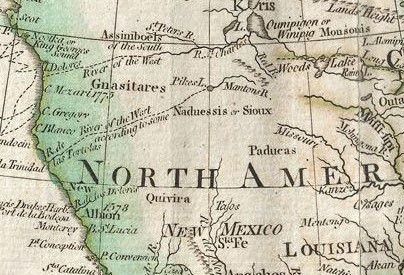 Zooming in on Dunn’s above map you can see two Rivers of the West flowing into the Pacific. Perhaps folks were still trying to decide, or hedging their bets.
Zooming in on Dunn’s above map you can see two Rivers of the West flowing into the Pacific. Perhaps folks were still trying to decide, or hedging their bets.
Meanwhile Canadian fur traders had begun to consider the overland route to the Pacific. Alexander Mackenzie, a partner in the Canadian North West Company, became a firm skeptic of the northwest passage after following a large river into the northern interior in hopes of locating the mythical route, only to find that this river emptied into the Arctic. Convinced that no northwest passage for sea vessels existed, he insisted if Canadians wanted to reach the Pacific from Hudson’s Bay they should go overland.
Mackenzie organized an expedition to do just that, intending to cross the Rockies, then go down the River of the West. His party came across a major waterway, which he assumed to be this elusive stream, but he discovered it was not the river dubbed Columbia by the American Captain Gray, but a more northerly river which would be named the Fraser. Mackenzie’s party reached the coast at Port Meares in July 1793 after a harrowing journey, the first transcontinental crossing north of Mexico.
Jefferson must have been pondering all this when the international winds shifted again, and Napoleon’s dilemma became Jefferson’s boon. The United States had been negotiating with France for New Orleans, because the Americans wanted the mouth of the Mississippi. But when the entirety of the Louisiana Territory, once a French possession, was dropped back into Napoleon’s lap through various treaties, he knew he was no longer in a position to protect it, and he greatly feared that his arch enemy, the British, now ensconced in Canada, would ultimately take it from him.
Jefferson was just as fearful at the prospect of the powerful French on his border, but he didn’t want to make this longtime friend an adversary. He was surprised when Napoleon offered to sell the Louisiana Territory to the United States for a song, and suddenly the fledgling US nation nearly doubled its size.
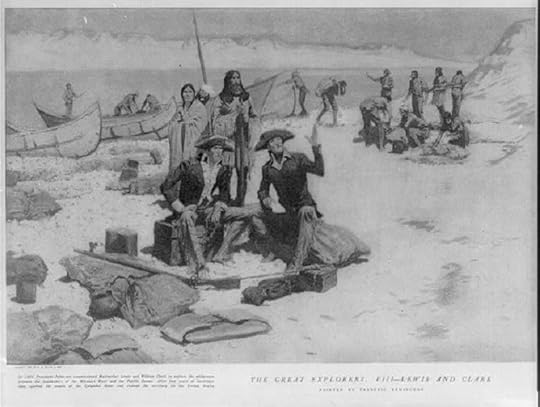 The Great Explorers – Lewis & Clark: Halftone reproduction of drawing by Frederic Remington in Collier’s Magazine, 1906 May 12, from Library of Congress.
The Great Explorers – Lewis & Clark: Halftone reproduction of drawing by Frederic Remington in Collier’s Magazine, 1906 May 12, from Library of Congress.
The Americans didn’t know much about the Louisiana Territory, not even the boundaries on the north and south, though its western boundary lay somewhere along the crest of the Rockies. Louisiana now provided that contiguous link with the territory of the west. So Jefferson sent out Meriwether Lewis and William Clark to see what the United States had bought and to explore and map the region. However, he didn’t want them to stop at the western edge of the newly acquired Louisiana, but to continue into the west to explore that land of uncertain possession, including the intriguing river their compatriot Gray had discovered.
Leaving St. Louis in the spring of 1804, Lewis and Clark proceeded up the Missouri River, crossed the Rocky Mountains and came down the Clearwater River to the Snake before making their way into the Columbia River, which they navigated all the way out to Young’s Bay. The Columbia proved to be a magnificent waterway, but not a northwest passage, given the ruggedness of the land between it and the east flowing streams. A young member of the expedition named John Colter would later gain fame for adventures upon his return into the mountains to look for furs, leading many to call him the first mountain man. More about him in the next post.
When Lewis and Clark returned to the States in 1806, Americans became excited about commercial possibilities in the west. Fur dealer John Jacob Astor approached the North West Company about joining forces, but when they refused, he founded his own Pacific Fur Company. He sent out two parties to the Columbia, one by land, led by Wilson Price Hunt, and one by sea aboard the Tonquin.
Men from the Tonquin arrived in the Columbia in March 1811 and set up a trading post on the south bank, naming it Fort Astoria. The overland party straggled in almost a year later after a grueling trek.
 The above 1813 sketch of Fort Astoria was created by Gabriel Franchère, one of Astor’s men from the Tonquin, and later published in 1819 with Franchère’s account of the venture.
The above 1813 sketch of Fort Astoria was created by Gabriel Franchère, one of Astor’s men from the Tonquin, and later published in 1819 with Franchère’s account of the venture.
At about the same time, the Canadian North West Company sent David Thompson over the mountains to establish fur trading posts and continue to the mouth of the Columbia. The Astorians offered Thompson a friendly greeting, but the War of 1812 erupted, putting the men on opposite sides of the conflict. Through a complicated series of events, the fort of Astoria was sold under some duress and turned over to the Canadians. A British warship, the HMS Raccoon, entered the Columbia soon afterward, its captain hoping to capture the fort, but the sale had already occurred.
Author Robert C. Johnson, in his book John McLoughlin, describes the disappointment of the warship’s Captain William Black when he saw Fort Astor. “‘What! Is this the fort I have heard so much of?’ exclaimed Black. ‘Good God, I could batter it down with a four-pounder in two hours.'” He took possession and renamed it Fort George after the British king.
When this news reached Astor in New York he was not pleased, but the deed was done. Given the remoteness of the fort, its sale and surrender were unknown to negotiators of the Treaty of Ghent ending the war in 1814. The treaty provided that territory and possessions taken by one nation from the other should be restored. Because of this agreement, the British were expected to restore Fort George to the Americans. However, a question remained as to whether the fort was taken or sold. That and other controversies between the nations led to another treaty in 1818 to settle the boundary issues in the region.
Spain and Russia also came into the question, but the United States was haggling with Spain over Florida and didn’t want to press too hard on the southern boundary with Spain, though the line was established the next year at the 42nd parallel. Russia was pushing for a boundary in the north where they would take all territory down to the 51st, but neither Britain or the United States would accept that and finally negotiated it back to 54-40. With Spain and Russia settled, that left the Americans and the British.
The US claim to the territory was founded on Gray’s discovery of the Columbia, the Lewis and Clark expedition, the founding and restoring of Astoria, and the title acquired from Spain. After settling with the Spanish, the United States contended that any rights Spain possessed as a result of discovery had passed to the United States. The British claim was based on early voyages along the northwest coast, land exploration by Mackenzie, North West Company posts on the Columbia and Fraser Rivers, and Broughton’s ascent up the Columbia River.
The 1818 treaty set the boundary between Britain and the United States at the 49th parallel from the Lake of the Woods to the Stony Mountains, the Rockies, each nation ceding some land to make a straight border, but at the Rockies they hit a snag. Americans suggested continuing the 49th parallel to the coast, though many of their countrymen wanted to push the British north all the way to 54-40. Britain wanted the boundary to drop southward and follow the Columbia River so they could retain the lucrative fur trade there. With the two sides unable to agree, the treaty declared that the Oregon territory be jointly occupied between the United States and Britain for 10 years, giving them time to settle on a boundary between them. The treaty allowed both nations the right of settlement and trade, but neither could claim title to the land. Agreement would take much longer than 10 years.
While the Americans and British hassled over the details of negotiation, another virtual war raged between the Montreal-based North West Company and the other major British fur company doing business in the region, the London-based Hudson’s Bay Company, resulting in the deaths of many trappers and traders. To end hostilities the beleaguered companies finally merged in 1821 under the Hudson’s Bay Company.
The history of the restoration of Fort George (Astoria) to the United States seems a little murky. As the 1818 treaty was concluding, a representative of the US government arrived at the fort to receive the fort’s surrender, and the US flag was raised. By some accounts, as soon as the US representative sailed away, the US flag came down. In any case, the Canadian North West Company continued to maintain the post, perhaps for lack of further US action, and when that company ceased to exist, the British Hudson’s Bay Company took it over, more or less by default.
Dr. John McLoughlin, formerly an employee of the North West Company, became a Hudson’s Bay Company man and was assigned in 1824 as commander of the HBC western district. He would soon make a grand entry at Fort George.
Carey, Charles H., LLD. General History of Oregon: Through Early Statehood. Portland, OR: Binfords & Mort, 1971.
Johnson, Robert C. John McLoughlin: “Father of Oregon.” Portland, OR: Binfords & Mort, 1958.
Various websites.
Next: Mountain Men





